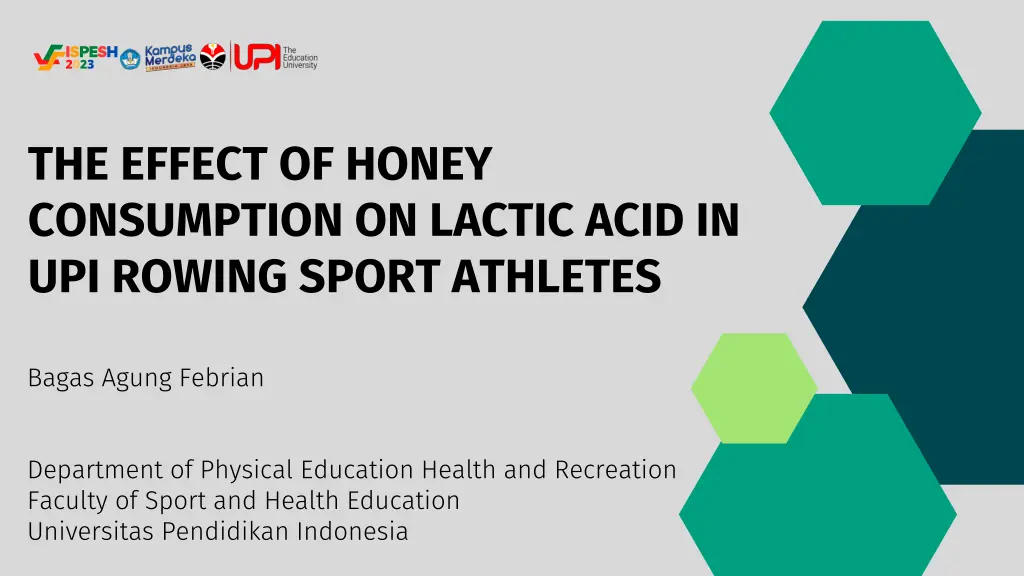
Effect of Honey Consumption on Lactic Acid in Rowing Athletes
Investigate the impact of honey consumption on lactic acid levels in UPI rowing sport athletes. High lactic acid can lead to fatigue, affecting performance. Honey, a natural carbohydrate source, may aid in providing energy and improving athlete endurance. This quantitative research involves UPI rowing athletes and aims to enhance performance through a controlled experimental design.
Download Presentation

Please find below an Image/Link to download the presentation.
The content on the website is provided AS IS for your information and personal use only. It may not be sold, licensed, or shared on other websites without obtaining consent from the author. If you encounter any issues during the download, it is possible that the publisher has removed the file from their server.
You are allowed to download the files provided on this website for personal or commercial use, subject to the condition that they are used lawfully. All files are the property of their respective owners.
The content on the website is provided AS IS for your information and personal use only. It may not be sold, licensed, or shared on other websites without obtaining consent from the author.
E N D
Presentation Transcript
ISPESH 2023 THE EFFECT OF HONEY CONSUMPTION ON LACTIC ACID IN UPI ROWING SPORT ATHLETES Bagas Agung Febrian Department of Physical Education Health and Recreation Faculty of Sport and Health Education Universitas Pendidikan Indonesia
ISPESH 2023 In row ing, there are physical com ponents that are dom inantly needed by row ing athletes, nam ely endurance, flexibility and strength. G eneral endurance and endurance of the arm and abdom inal m uscles are im portant physical com ponents for row ing athletes. This is really needed by a row ing athlete because w hen com peting they are required to m ake continuous row ing m ovem ents w ith the rhythm needed so that the boat used can run quickly and according to its path (D ebrito & N urkholis, 2013). INTRODUCTION A s part of perform ance sports, it is definitely required to get the best perform ance, therefore the training program given to athletes has a high intensity w ith the aim of im proving the athlete's abilities both in physical and technical abilities so that the athlete's opportunity to achieve achievem ent is not too difficult. .
ISPESH 2023 H igh levels of lactic acid in athletes can produce adverse effects by accelerating the onset of fatigue (C andra et al., 2016). L actic acid is the end result of anaerobic m etabolism , a process that occurs w ithout the presence of oxygen. W hen exercising physically, there is an increase in the concentration of lactic acid in the blood and m uscles. The accum ulation of lactic acid in blood circulation is a critical issue in physical perform ance, causing ongoing fatigue and reducing the efficiency of physical perform ance (W idiyanto, 2015). H igh intensity training can cause fatigue w hich affects the athlete's physical condition. One m ethod of providing energy for athletes during training and com petition is by providing drinks containing carbohydrates (W illiam s et al., 2012). The availability of blood glucose during training or com petition is one of the factors that influences endurance perform ance. C onsum ing drinks containing sim ple carbohydrates during training or com petition can help im prove athlete perform ance by m aintaining blood glucose levels and delaying fatigue. H oney, as a natural carbohydrate source, can act as an energy provider in endurance sports (A nggraini & M urbaw ani, 2013). H oney consists of several types of m ono- and di-saccharides, w ith fructose (~35-40%) and glucose (~30-35%) as the m ain com ponents. A part from that, honey also contains w ater, polyphenols, vitam ins and m inerals. In research, it has been identified that consum ption of several of these constituents separately can im prove exercise perform ance through ergogenic effects (M itchell, 2019). Several studies show that honey has potential as an antioxidant, anti-inflam m atory, antibacterial, antihyperlipidem ic, antidiabetic and anticancer (R ao et al., 2016). antiviral, antiulcer,
ISPESH 2023
ISPESH 2023 This type of research is quantitative research because this research uses an experim ental research m ethod w ith a P retest-P osttest C ontrol G roup design (initial test - final test of tw o groups) The research population w as all m em bers of the U PI R ow ing Sports U K M , totaling 14 people. The sam ple used w as a saturated sam ple of U PI R ow ing U K M athletes (total sam pling) totaling 14 people, then the sam ple w as divided into tw o groups using a purposive sam pling technique, nam ely by dividing the sam ple into tw o groups evenly based on the athletes' abilities as seen from the tim e records. after carrying out a row ing ergom eter test w ith a distance of 2000 M METHODS Treatm ent w as given to the experim ental group by consum ing honey 90 m inutes before exercise at a dose of 70 gram s dissolved in 250 m l of w ater (H ajizadeh M aleki et al., 2016). D ata analysis used in this research is using the P aired Sam ple t test and Independent Sam ple t test techniques using the SPSS V ersion 26 program .
ISPESH 2023 Tabel 1. Hasil Uji Paired Sample t test Paired Samples t test Nilai Taraf Siginifikan Ket. Mean Std. Deviation Sig. (2-tailed) Pair 1 Kelompok Kontrol -.2143 .4741 .277 > 0,05 Tidak Signifikan Kelompok Eksperimen Pair 2 1.8714 .2430 .000 < 0,05 Signifikan RESULTS B ased on the results of the paired sam ple t test in table 1, it can be explained that: a. A t the P air 1 output, the control group obtained a sig value. (2 tailed) is 0.277 > 0.05, so it can be concluded that there is no significant difference in test results w hen carrying out the P re Test and P ost Test in the control group. b. In the P air 2 output, the experim ental group obtained a sig value. (2 tailed) of 0.000 < 0.05, it can be concluded that there are differences in test results w hen carrying out the P re Test and P ost Test in the experim ental group.
ISPESH 2023 Tabel 2. Hasil Uji Independent Sample t test Independent Samples t test t-test for Equality of Means Sig. (2-tailed) Levene's Test for Equality of Variances RESULTS F Sig. Taraf Signifikan Ket. Asam Laktat .296 .596 .000 < 0.05 Signifikan B ased on table 2, it can be explained that the results of the data for calculating the value of L actic A cid obtained a value of Sig. (2tailed) 0.000 < 0.05. From the results of the independent sam ple t test table, it is clear that there is a difference in the average results of L actic A cid in the control group and the experim ental group. So it can be said that the proposed hypothesis in this research can be accepted because it gets significant value.
ISPESH 2023 From the results of the data that has been tested using the paired sam ple t test and independent sam ple t test on lactic acid, it is clear that the value obtained show s <0.05, then H 0 is rejected and H 1 is accepted, w hich m eans that there is an effect of giving honey on reducing lactic acid in U PI R ow ing U K M athletes. . B ased on research and testing data that has been carried out, significant results w ere obtained from the experim ental group w ho drank honey before training at a dose of 70g + 250 m l of w ater com pared to the control group w ho did not drink honey. The results obtained by the experim ental group show ed that honey had an influence on L actic A cid in U PI R ow ing U K M A thletes. D uring the training program , all sam ples carried out joint exercises, but only the experim ental group (the group that drank honey) show ed a decrease in lactic acid. This provides evidence that consum ing honey can help im prove athletes' physical perform ance during training. This is because honey consum ed during training is a good natural supplem ent for athletes because it contains lots of carbohydrates, protein, vitam ins and m inerals w hich are useful for m eeting the glycogen needs of athletes' bodies (R usdiatin et al., 2016), so the honey consum ed is has an effect on reducing lactic acid levels because it can increase general endurance and m uscle endurance. DISCUSSION
ISPESH 2023 From the theory and discussion explained, honey has m any nutrients needed by m uscle cells so they don't tire easily so honey has a good role in helping increase general endurance and m uscle endurance in athletes during training. B ased on the results of data analysis and discussion of the theory used in this research, it can be concluded: there is an effect of giving honey on reducing L actic A cid in U K M U PI R ow ing Sports A thletes. CONCLUSION
ISPESH 2023 Alim, A. (2012). Persepsi atlet terhadap kebutuhan cairan (hidrasi) saat latihan fisik dan recovery pada unit kegiatan mahasiswa olahraga Universitas Negeri Yogyakarta. 1 13. Anggraini, A. D., & Murbawani, E. A. (2013). Pengaruh Konsumsi Minuman Madu Terhadap Kadar Glukosa Darah Atlet Sepak Bola Remaja Selama Simulasi Pertandingan. Journal of Nutrition College, 2(3), 339 349. https://doi.org/10.14710/jnc.v2i3.3435 Badriah, D. L. (2009). Fisiologi Olahraga edisi II. Pustaka Ramadhan. Candra, A., Rusip, G., & Machrina, Y. (2016). The Effect of Aerobic Exercise to Lactic Acid and Borg Scale Football. Jurnal MKMI, 12(1), 7 13. Debrito, Y., & Nurkholis. (2013). SURVEI KONDISI FISIK ATLET DAYUNG PERAHU NAGA PUTRI DI KLUB BADJOEL SURABAYA. Jurusan Pendidikan Kepelatihan Olahraga FIK Unesa, 1(1), 1 9. Hajizadeh Maleki, B., Tartibian, B., Mooren, F. C., Kr ger, K., FitzGerald, L. Z., & Chehrazi, M. (2016). A randomized controlled trial examining the effects of 16 weeks of moderate-to-intensive cycling and honey supplementation on lymphocyte oxidative DNA damage and cytokine changes in male road cyclists. Cytokine, 88, 222 231. https://doi.org/10.1016/j.cyto.2016.09.016 &pgis=1 REFERENCE
ISPESH 2023 Ilia, G., Simulescu, V., Merghes, P., & Varan, N. (2021). The health benefits of honey as an energy source with antioxidant, antibacterial and antiseptic effects. Science & Sports, 36(4), 272.e1-272.e10. https://doi.org/10.1016/J.SCISPO.2020.10.005 Millah, H., Sudjarwo, I., & Subekti, N. (2018). SOSIALISASI ATURAN BEROLAHRAGA YANG BENAR SESUAI DENGAN RUMUS TKPE (Upaya Meningkatkan SDM Guru Olahraga SMA dan SMP di Lingkungan MGMP Kota Tasikmalaya). Jurnal Pengabdian Siliwangi, 4(2), 157 160. Mitchell, P. I. (2019). The Physiological and Performance Effects of Honey Consumption in Sport and Exercise: A Systematic Review. May. https://etheses.whiterose.ac.uk/27266/ Muh. Yusuf, Dra. Ichsani Basith M.Kes, Abdul Rahman S.Or, M. P. (2019). Pengaruh Massage Olahraga Terhadap PenurunanAsam LaktatAtlet Hoki FIK UNM. Ilmu Keolahragaan. Pratama, N. E., Pd, M., Sulastio, A., Pd, S., & Pd, M. (n.d.). RELATIONSHIP BETWEEN THE STRENGTH OF THE MUSCLE AND THE CURRENT STRENGTH ON THE RIDING RESULTS IN. 7, 1 10. Qiu, Shanhu. Cai, Xue. Sun, Zillin. Li, Ling. Zuegel, Martina. Steinacker, Juergen Michael. Schumann, U. (2017). Heart rate recovery and risk of cardiovascular events and all-cause mortality: A meta-analysis of prospective cohort studies. Journal of the American Heart Association, 6(5). https://doi.org/10.1161/JAHA.117.005505 REFERENCE
ISPESH 2023 Rasyono. (2016). Ekstrakurikuler Sebagai Dasar Pembinaan Olahraga Pelajar. Journal of Physical Education Health and Sport, 3(1), 44 49. Rusdiatin, I. E., Djuanidi, A., & Sofro, Z. M. (2015). PENGARUH KONSUMSI MADU SELAMA PROGRAM LATIHAN AEROBIK TERHADAP PERFORMA LATIHAN SUBJEK PEMULA. Rusdiatin, I. E., Sofro, Z. M., & Djunaidi, A. (2016). Efek Konsumsi Madu Selama Olahraga Terhadap Frekuensi Denyut Jantung Beban Maksimal Subyek Pemula. Jurnal Kesehatan Madani Medika, 7(1), 15 19. Safitri, N., Pitriani, P., Mulyana, M., Simbolon, M., Hamzah, A., & Sartika, D. (2020). Effect of Honey on Measurable Sport. https://doi.org/10.2991/ahsr.k.200214.094 Sandi, I. N. (2016). Pengaruh Latihan Fisik Terhadap Frekuensi Denyut Nadi. 4(2), 1 6. Sugiyono. (2014). Metodelogi Penelitian Kuantitatif, Kualitatif Dan R&D. In Resma (Vol. 3, Issue 2).ALFABETA. Widiyanto, -. (2015). Latihan Fisik Dan https://doi.org/10.21831/medikora.v0i1.4720 Widowati, A., & Setiowati, A. (2019). Penggunaan Ergometer Rowing Terhadap Peningkatan Power EnduranceAtlet Rowing Jambi. Jurnal Cerdas Sifa, 1(2), 72 75. Williams, M., Anderson, D., & Rawson, E. (2012). Nutrition for Health, Fitness & Sport. In McGraw Hill Education. https://books.google.com/books?id=DZqrXwAACAAJ REFERENCE 21(Icsshpe 2019), 351 354. Asam Laktat. Medikora, 1, 61 79.






















